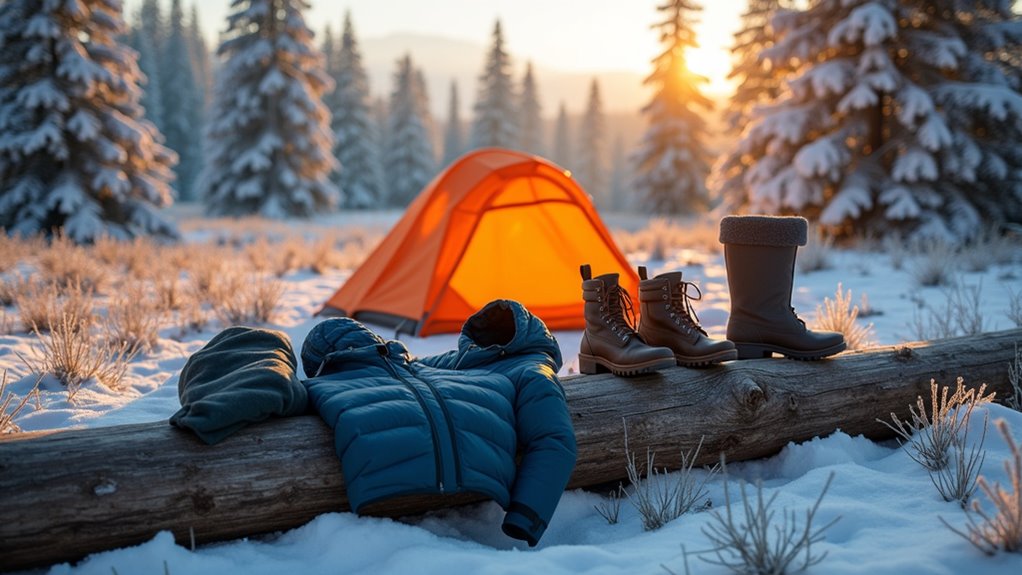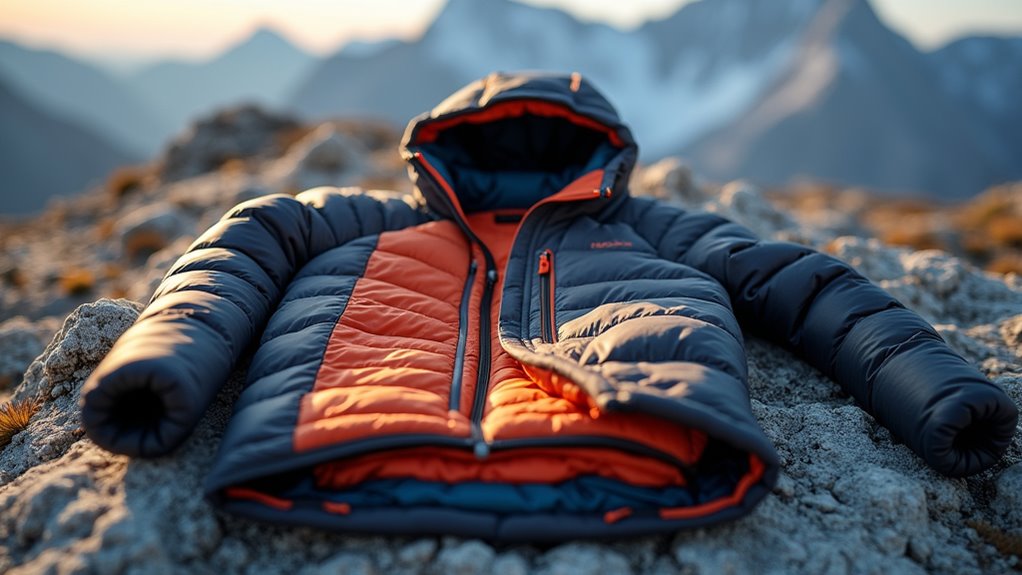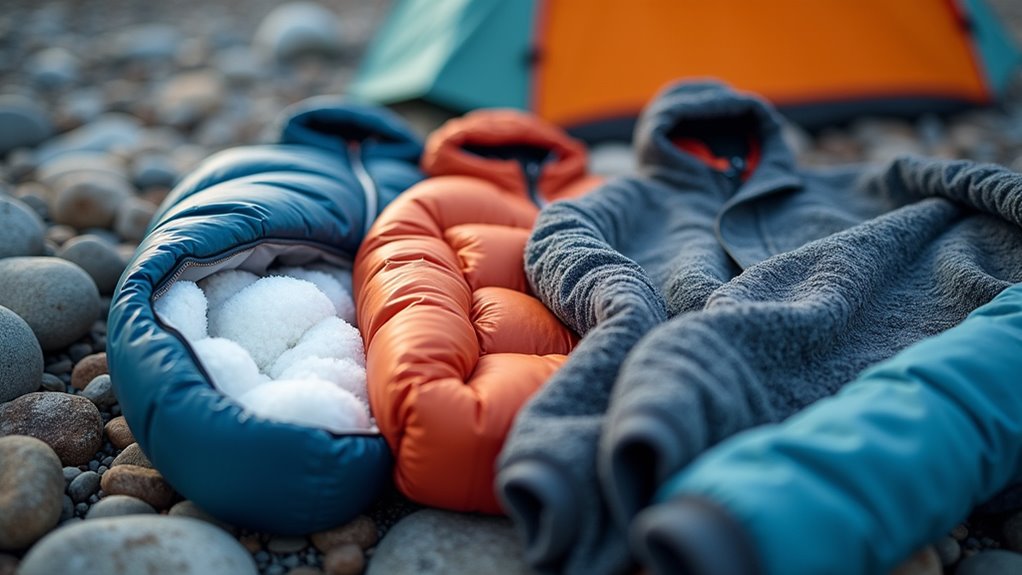Physical Address
304 North Cardinal St.
Dorchester Center, MA 02124
Physical Address
304 North Cardinal St.
Dorchester Center, MA 02124

Winter camping survival depends on these 8 essential dressing strategies that prevent hypothermia and keep you warm without expensive gear.
Last February, a seasoned hiker nearly got hypothermia in Yellowstone because he wore cotton layers that trapped moisture against his skin. You don’t need expensive gear to stay warm and safe during winter camping, but you do need the right approach to layering. Smart dressing choices can mean the difference between an enjoyable adventure and a dangerous situation. These eight proven tips will help you stay comfortable without breaking your budget or compromising your safety.

When temperatures drop and wind cuts through inadequate clothing, you’ll quickly learn why experienced winter campers swear by the three-layer system. This approach maximizes warmth while preventing dangerous overheating and moisture buildup.
Your base layer wicks sweat away from skin—choose merino wool or synthetic materials, never cotton. You don’t need expensive brands; budget options work fine if they’re moisture-wicking.
Cotton kills in cold weather—stick to merino wool or synthetic base layers that actually move moisture away from your body.
The insulating middle layer traps warm air. Fleece jackets, down vests, or synthetic-fill garments all work well. Thrift stores often stock quality fleece at great prices.
Your outer shell blocks wind and precipitation. Look for breathable, waterproof jackets with ventilation zippers. You can adjust warmth by adding or removing layers rather than suffering through temperature swings.
While winter camping presents unique challenges, the layering principles remain essential for desert hiking where temperature swings between day and night can be equally dramatic.
Cotton kills—that’s not winter camping hyperbole, it’s a survival fact you can’t ignore. When cotton gets wet from sweat or snow, it loses all insulating properties and pulls heat from your body. You’ll freeze faster than you’d think.
Instead, choose synthetic materials like polyester or merino wool for your base layer. These fabrics wick moisture away from your skin and retain warmth even when damp.
Polyester’s cheaper and dries quickly, making it perfect for budget-conscious campers. Merino wool costs more but offers superior odor resistance and temperature regulation.
Look for snug-fitting base layers without being restrictive. Avoid seams in high-friction areas. Your base layer’s job is moving sweat away from skin, so prioritize function over fashion.
These camping tricks will help ensure you stay warm and dry throughout your winter adventure.

Your insulation layer’s job changes dramatically based on whether you’re hiking uphill with a heavy pack or setting up camp in bitter cold. Match your insulation to your activity level to avoid overheating or freezing.
For high-output activities like hiking, you’ll want breathable insulation that vents excess heat:
During low-activity periods like cooking or sleeping, prioritize maximum warmth retention. Down jackets excel here despite their higher cost – they’re incredibly warm for their weight and pack small.
Remember that proper layering is just one element of creating a memorable camping experience that keeps you comfortable and safe in winter conditions.
While your insulation layers handle warmth, your outer shell serves as the vital barrier between you and harsh winter conditions. You’ll need a jacket that blocks wind and snow while allowing sweat vapor to escape. Look for shells with Gore-Tex or similar waterproof-breathable membranes – they’re worth the investment.
Don’t skimp on features like adjustable cuffs, a helmet-compatible hood, and two-way zippers. These details matter when you’re setting up camp in a blizzard. Pit zips provide essential ventilation control during high-activity periods.
Consider your budget carefully. A mid-range shell from reputable brands often outperforms expensive options with unnecessary features. Check for sales at the season’s end, and remember that a quality shell should last multiple seasons with proper care. Unlike desert camping where sun protection is the primary concern, winter environments demand shells that prioritize wind and moisture resistance above all else.

When temperatures plummet, frostbite targets your fingers and toes first, making proper glove and sock selection critical for safe winter camping. You’ll need a layering system that keeps extremities warm while maintaining dexterity and preventing moisture buildup.
For gloves, choose a liner-and-shell combination rather than bulky mittens. Thin merino wool liners provide warmth while allowing finger movement for camp tasks, while waterproof shells protect against wind and snow.
Your sock strategy should include:
Change socks if they become damp, and always pack extras. Winter camping enthusiasts often travel to remote locations using an RV purchase as their mobile base camp, allowing them to store extra gear and warm up between outdoor activities.
Since your body loses up to 40% of its heat through your head and neck, covering these areas isn’t optional—it’s essential for preventing hypothermia in winter conditions.
A wool or fleece beanie works best for your head, as these materials retain warmth even when wet. Skip cotton hats—they’ll make you colder once they get damp from sweat or snow.
For your neck, pack a lightweight buff or fleece neck gaiter that you can pull up over your face when temperatures drop.
Don’t forget a backup hat in case your primary one gets wet. A simple wool skull cap costs under $15 and weighs almost nothing in your pack. You can also layer a thin beanie under a warmer hat for extra insulation during the coldest nights.
When nature calls during those frigid nights, having a portable camping toilet ready means you won’t have to expose your head to the elements while searching for appropriate outdoor facilities in the dark.

As your activity level changes throughout the day, you’ll need to add or remove layers to maintain the right body temperature. Getting this balance right prevents overheating during active periods and keeps you warm during rest.
Pay attention to these key adjustment points:
Don’t wait until you’re already sweating or shivering to make changes. Anticipate your body’s needs and adjust proactively.
This simple habit will keep you comfortable without breaking your gear budget. Plus, keep first aid supplies easily accessible when adjusting layers in challenging weather conditions, as accidents can happen more easily when your dexterity is compromised by cold temperatures.
Even the best layering system fails if your backup clothes get soaked, so you’ll need waterproof storage to protect your extra gear. Don’t overthink this—heavy-duty trash bags work just as well as expensive dry bags for most winter camping trips. Double-bag your spare clothes and squeeze out excess air before sealing.
Pack at least one complete change of base layers, extra socks, and backup insulation layers. Keep these emergency clothes separate from your daily-use items so they stay completely dry. Store them at the bottom of your pack where they won’t get accidentally accessed.
Consider packing one set in your sleeping bag stuff sack for guaranteed dryness. If everything else gets wet, you’ll have warm, dry clothes waiting. When winter camping season ends, follow proper gear storage techniques to ensure your waterproof bags and extra clothing remain in good condition for next year’s adventures.
You’ve built your armor against winter’s relentless siege—each layer a shield, every piece of gear a weapon in your survival arsenal. Don’t let budget constraints freeze your adventures; smart shopping and proper care stretch your dollars like wool stretches warmth. Your clothing isn’t just fabric—it’s your lifeline when nature shows no mercy. Stay vigilant, adjust constantly, and remember: the mountain doesn’t care about your comfort, but your layers do.